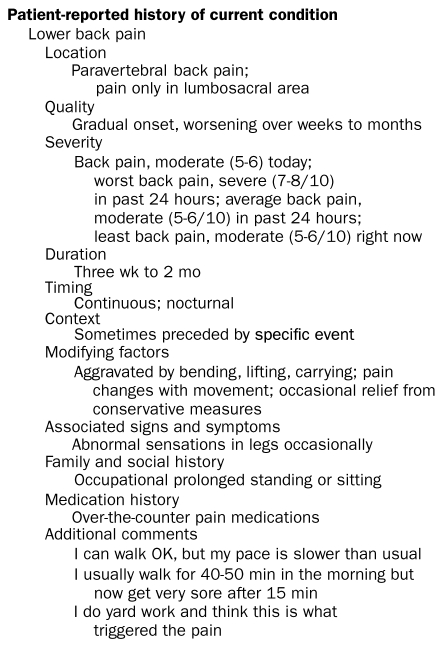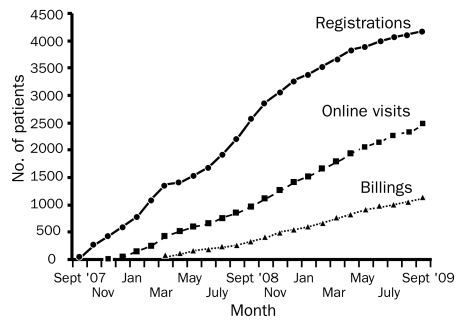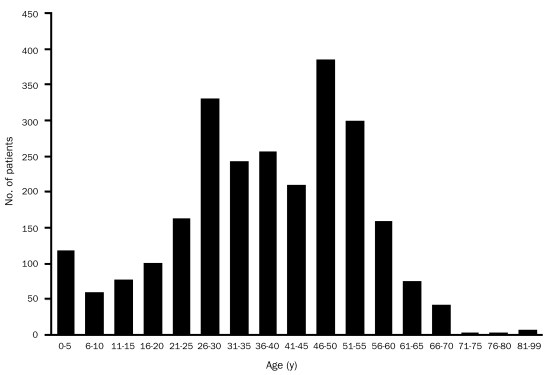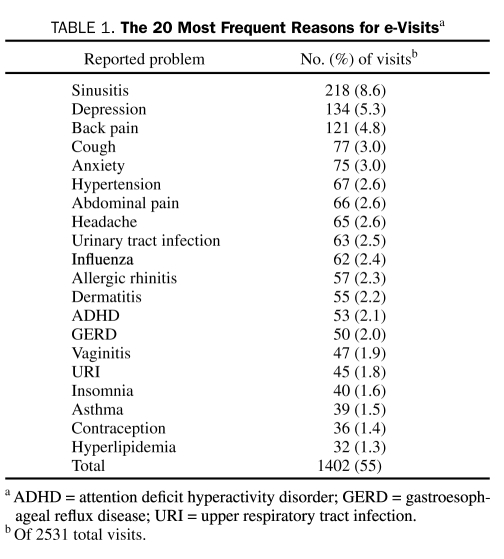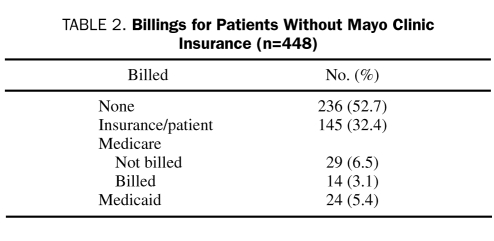Abstract
OBJECTIVE: To study the use of e-visits in a primary care setting.
PATIENTS AND METHODS: A pilot study of using the Internet for online care (“e-visits”) was conducted in the Department of Family Medicine at Mayo Clinic in Rochester, MN. Patients in the department preregistered for the service, and then were able to use the online portal for consultations with their primary care physician. Use of the online portal was monitored and data were collected from November 1, 2007, through October 31, 2009.
RESULTS: During the 2-year period, 4282 patients were registered for the service. Patients made 2531 online visits, and billings were made for 1159 patients. E-visits were submitted primarily by women during working hours and involved 294 different conditions. Of the 2531 e-visits, 62 (2%) included uploaded photographs, and 411 (16%) replaced nonbillable telephone protocols with billable encounters. The e-visits made office visits unnecessary in 1012 cases (40%); in 324 cases (13%), the patient was asked to schedule an appointment for a face-to-face encounter.
CONCLUSION: Although limited in scope, to our knowledge this is the largest study of online visits in primary care using a structured history, allowing the patient to enter any problem, and billing the patient when appropriate. The extent of conditions possible for treatment by online care was far-ranging and was managed with a minimum of message exchanges by using structured histories. Processes previously given as a free service or by nurse triage and subject to malpractice (protocols) were now documented and billed.
During this 2-year study, 4282 patients registered for online care (“e-visits”) with their primary care physicians; patients made 2531 e-visits, and billings were done for 1159 patients. Structured histories allowed a wide extent of conditions to be treated with minimal message exchanges.
Some fundamental aspects of transforming primary care include eliminating barriers to access, using technology to communicate with patients, and enhancing financial performance.1 Currently, it is possible for patients to use the Internet to see laboratory test results, make appointments, pay bills, and review their charts.2 Some reports have shown improved patient satisfaction with use of these options.3-5 Several articles have discussed electronic messaging (e-mails) as a way to improve efficiency by decreasing patient telephone calls to the physician's office.6-9 Various reports have described the use of the Internet to manage conditions such as depression,10,11 diabetes mellitus,12 hypertension,13,14 and sexually transmitted diseases15 and also to assist with breastfeeding support,16 previsit well child encounters,17 and communication with patients in safety net practices.18 Guidelines have been established for providing medical care on the Internet (“e-visits”).19 Patients in primary care practices also have indicated a willingness to pay for online services.20
However, implementation of billable e-visits has been slow. “Reasons for provider hesitation to adopt e-visit technologies include fears of being overburdened by electronic communication, improper use of electronic communication by patients, lack of reimbursement schemes, legal and regulatory issues, and concerns over security, privacy, and confidentiality.”21 Also, electronic consultations to date have generally used online forms or secure e-mail. The information in these formats is unstructured and often lacks sufficient information, prompting the clinician to respond to the patient to request further information, which results in delays.22 Furthermore, the lack of organization in an e-mail makes it difficult to code complexity; consequently, the same fee is often charged for all online consultations, regardless of complexity.23
For editorial comment, see page 701
Isolated reports of the use of online consultations have been disappointing. For example, despite indications that electronic communication could decrease health care costs24 and provide reimbursement from patients,25,26 Fairview Health System has reported only 10 e-visits per week in a system with 400 physicians,27 and Blue Cross of Minnesota processed about 30 e-visits per month in July 2008 and 90 e-visits per month in July 2009 (D. Hiza, MD, written communication, February 2010).
Studies have not described a portal for online patient consultations that has a structured medical history. Structured computerized histories were first described in the 1960s by Mayne et al28 and Slack et al.29 Their work included using the telephone and teletype with patients from distant locations providing their histories.30 The evidence for using computerized histories to produce more organized histories, detect new symptoms, and provide greater patient satisfaction with improved clinician performance has been reviewed.31
We conducted a pilot study of online patient visits in a primary care setting using structured histories and the possibility of the patients being billed for the service.
PATIENTS AND METHODS
The pilot study was conducted from November 2007 through October 2009 in the Department of Family Medicine at Mayo Clinic, Rochester, MN. The Department of Family Medicine averages 56 clinicians practicing in 4 clinics in and around Rochester. The study aimed to learn about the potential for online visits in preparation for construction of an online patient portal to be used for the entire institution. Numerous restrictions were placed on the pilot. The project did not receive publicity and was not actively promoted. Patients were required to be Minnesota residents and were identified in face-to-face encounters and preregistered for the project. A review board met monthly to discuss and control progression of the pilot.
A Health Insurance Portability and Accountability Act–compliant pilot platform was selected for the online visits (formerly Medfusion, Inc, Cary, NC; currently Intuit, Mountain View, CA),32 which incorporated the history-taking component from another company (Instant Medical History, Columbia, SC).33 For this article, an e-visit was defined as an electronic encounter that included history, diagnostic coding, billing, and medical intervention. In the basic e-visit process, patients entered their reported problem in free text (eg, “back pain”) and then answered questions one at a time. The questions branched such that the history was organized into a readable clinical format (Figure 1). In this study, the number of questions available for use exceeded 70,000. The software, besides allowing branching, used numerous validated instruments to enhance the quality of the online interview (eg, the Vanderbilt ADHD Diagnostic Rating Scale for attention deficit hyperactivity disorder [ADHD]; the PHQ-9 depression scale of the Patient Health Questionnaire for depression; and the Epworth Sleepiness Scale for sleepiness). As part of the e-visit, patients were asked to provide vital signs and to enter their medications in free text; the platform also contained areas for patients to upload files such as photographs and to enter additional history in free text to clarify their concerns after they had completed the questionnaires.
FIGURE 1.
Example of selected output from online consultation forms.
After completing the e-visit, the patient received an e-mail stating that his or her clinician would review the consultation within 24 hours. Another e-mail was forwarded to the clinician informing him or her of an e-visit waiting in the secure portal. The portal allowed the clinician to use templated encounter forms for many common illnesses so that information such as diagnostic codes, links to patient education, and treatment plans could be stored and reused. This standardization of treatment greatly speeded the process of reviewing an online visit. Medications were often prescribed during the process and faxed to the pharmacy. As a result of an institutional decision, medication prescriptions were ordered through the Mayo Clinic electronic medical record rather than through the portal. At the conclusion of the online visit, patients received an e-mail stating that the results of their encounter could be found on the portal. Patients would then log in and view the materials.
Results were monitored throughout the study, with monthly reports generated.
RESULTS
During the 2-year study period, 4282 patients were registered for the service, which led to 2531 online consultations and billings for 1159 patients (52%) (Figure 2). During the last 11 months of the study, expansion of registrations and e-visits was discouraged because of the expected release of a new Mayo Clinic portal. There was no billing for the first 4 months of the pilot, during which 299 visits occurred. After 6 months, a 1-month pause occurred in adding registrations (April 2008) to assess the effects on the practice.
FIGURE 2.
Cumulative totals of patient registrations, online visits, and billings at each month during the study period.
Patients using online visits were primarily women (1800 [71%]). Women also completed the e-visit intake form for many of the younger and elderly patients. The age of patients having online consultations ranged from 4 days (for diaper rash; a photograph was uploaded) to 86 years (2 patients; 1 for insomnia and 1 for hypertension) (Figure 3). Mean age was 38 years (median, 39 years; mode, 48 years). A total of 293 different conditions (International Classification of Diseases, Ninth Revision codes) were found among the online consultations. The most frequent reasons for e-visits are listed in Table 1. Families could set up joint accounts that linked members to one central account (eg, for parents to use the consults on behalf of their children); 288 patients (7% of total registrations) established family accounts, linking them to 520 patients (12% of total registrations).
FIGURE 3.
Ages of patients receiving online consultations.
TABLE 1.
The 20 Most Frequent Reasons for e-Visitsa
Generally, online consultations were completed by clinicians within 24 hours of the e-visit submission; only 11 were not completed because the patient became an inpatient or the clinician chose to contact the patient by telephone. E-visits were completed by the patient's primary care physician 89% of the time (2242 visits); 11% of the consultations (278 visits) were provided by an on-call clinician for absent physicians or if the patient selected “first available doctor.” E-visits were completed most frequently on Mondays (595 visits) and least frequently on Saturdays and Sundays (71 and 58 visits, respectively). The time of day during which e-visits was initiated was compiled during the second year; most visits occurred during working hours (between 8 am and 4 pm). Photographs accompanied the e-visit in 2% of the consultations (62 visits), most commonly pictures of diaper rash (13 pictures).
Types of visits that were not billed included refilling prescriptions (255 visits [11%]) and having the patient come in for an office visit (323 visits [14%]). The remaining visits were not charged because the patients had been seen the previous week for the same condition or because they were for follow-up of a stable condition.
Telephone protocols currently conducted by nursing staff have been used in the department for conditions such as conjunctivitis, influenza, sinusitis, urinary tract infections, and vaginitis. These protocols were used in 411 (16%) of the online consultations, therefore bypassing nursing staff. (We note that nurses have the potential to use online protocols in this portal, but it was not a part of this study.)
Mayo Clinic employees and their dependents made up the largest portion of e-visit users; their encounters were covered by insurance. Non–Mayo Clinic–insured employees or dependents made up 448 of the visits (18%) (Table 2). Of these, 159 (35%) received a bill. If the patient used Medicare, Medicare was billed, but the service was denied. Consequently, these patients paid from their own resources. If the patient was insured through Medicaid, Medicaid was billed, which was also denied; in these instances, the fee was waived. Non–Mayo Clinic and nongovernment plans received billings for 145 patients (32%) who were covered by this insurance. The cost of an e-visit was $35.
TABLE 2.
Billings for Patients Without Mayo Clinic Insurance (n=448)
A review of responses sent to the clinician in the second year showed responses for 397 (29%) of the 1366 visits. The most common response from the patients (121 responses [30%]) was acknowledging that they understood or thanking the clinician. This was actually a nuisance because clinicians logged into the portal to find messages that required no action.
Besides assessment, actions taken by clinicians included (1) writing a new prescription (1148 visits [45%]); (2) refilling a prescription (255 visits [10%]); (3) ordering radiographs and other procedures (264 visits [10%]); and (4) ordering laboratory studies (126 visits [5%]). Prevention issues were addressed by many of the physicians. One notable case was a prescription refill for headache medication, in which the clinician also ordered an overdue colonoscopy, which led to a localized cancer being detected and then resected.
We estimated that use of the e-visit prevented an office visit in at least 999 patients (40%). This estimate was obtained by subtracting the protocols from the billings during the billing period and adding follow-up visits to patients who had been seen in the clinic within a week (these were never charged). The 323 patients (13%) who were asked to come to the office also were not charged for the e-visit.
A total of 984 patients had just 1 online visit. One patient had 23 visits; this patient had several chronic conditions related to complications of a surgery, as well as depression.
DISCUSSION
The current study was a regulated pilot of online visits in a primary care setting. Most users were working-aged women who completed e-visits for themselves, their dependents, and their older parents during office hours. The clinicians were not overburdened by repeated visits during the study period or by overwhelming numbers of patients needing assistance.
Patient concerns were wide-ranging, with the top 20 diagnoses making up only 55% of the conditions. Other conditions varied from a request for circumcision to asking advice after surgical consultation. Uses for the e-visits included online consultations, sending photographs, and asking for prescription refills through the Internet portal. Use of the online visit for prescription refills was unexpected because patients already had access to a free online prescription refill service. With the e-visit, instead of the automated refill, the clinician could assess such issues as depression (Zung Self-Rating Depression Scale) when filling antidepressant medication prescriptions or performance while taking ADHD medications (Vanderbilt ADHD Diagnostic Rating Scale). The implications of this prescription refill process are unknown, but this method could possibly increase safety. The potential for determining effectiveness and adverse effects vs the time spent processing the refill requires further study.
Because patients could enter any symptom or concern, ask questions, and provide additional comments, the e-visits eliminated the need for clinicians to ask for further information in most instances. Excluding replies of “thank you” or acknowledgment of the information, only 20% of the consultations resulted in a request for more information. This was because the patient's history was organized, and pertinent information including all medications, allergies, and vital signs such as weight were always obtained. The volume of exchanges could be decreased further by emphasizing the need to send pictures of rashes, using the “no reply” feature of the software, and educating our clinicians that much of the information they requested is already in the note. For example, the most common clinician request for further information was the patient's preferred pharmacy to obtain the prescription. This was already in each note, but most clinicians did not realize where this information was stored.
Chronic Disease Management “Electronic Pit Stops”
Some consultations for patients with chronic disease seemed to show promise. For patients with diabetes mellitus, they first had laboratory tests and then were asked to complete an online visit regarding their diabetes. If all was well according to the interview and laboratory results, the patients did not need to visit the office. Hypertension was also managed online; patients sent in their blood pressure responses, and clinicians managed their medications and laboratory studies online. An intriguing possibility is for patients to have “electronic pit stops,” in which they would be sent electronic reminders for upcoming studies, followed by online consultations on a wider scale.
Messaging
Setting up messaging systems for patients to coordinate their care with physicians is possible. For example, all diabetic patients could be sent messages, or the entire primary care practice could be sent messages regarding H1N1 influenza updates. The possibility of sending a message on a patient's birthday to prompt an online consultation on preventive care was explored and found to be feasible. The use of messaging was outside the scope of this pilot, but it is worthy of further research.
Treatment Plans
Using treatment plans to expedite a reply was very efficient. Clinicians could respond to a reported problem using a premade note that included medications, patient education, diagnostic codes, and instructions. This saved time on simple administrative tasks, such as finding the right patient education materials or diagnostic codes. Clinicians also could make their own notes and save the pertinent items for reuse. In this pilot, only clinicians could review online visits. Further time could be saved by using other health care professionals, such as nurses; however, that strategy was considered outside the scope of this pilot. Protocols and triage by nursing staff would be in the scope of practice for nurses.
Speed of Consultation
The speed of consultation was not measured because the system did not allow us to see response times. Although 24 hours was allowed for a reply, clinicians handled most of their visits during office hours, either between patient visits or at the end of the morning or afternoon clinics. Consultations by the first available clinician or on week-ends were used infrequently, possibly because patients were unaware of this service. A clinician potentially could manage the on-call responsibilities by checking the computer a few times a day on the weekends or simply by being notified by mobile telephone. The impact of online consultations on emergency department or urgent care visits is worth further study; comparing e-visits with traditional calls to the office or nurse lines would be interesting. The advantage of structured histories obtained online vs by telephone is that questions can be asked quickly online and can be answered asynchronously.
Billing
Billing was included as part of this pilot. The percentage of Mayo Clinic employees billed was higher than that for nonemployees. The e-visit was reimbursed for employees who used insurance. For patients who used Medicaid, Medicaid was billed but not reimbursed. The costs associated with these visits were absorbed and thought to be a good tradeoff vs the cost of office visits for these patients (the margin of loss was greater with an office visit than with an online visit). Medicare claims were automatically denied, and these e-visits were billed to the patient. In the capitated patient population of our employees, because of e-visits, they did not need to leave work to bring dependents to the office or for contagious diseases (eg, H1N1 influenza), which was valuable to the employer, the insurance company, the clinician, and the patient. This lends credence to Kaiser Permanente's goal of providing an online service at lower costs to all its members nationwide.34 A report from a primary care setting involving 390 patients who had office visits and 376 patients who had e-visits showed decreased costs with e-visits vs office visits during a 6-month period.35
Online Portal Use
Patients used the online portal responsibly. No patients required triage to the emergency department. Some clinicians discouraged their patients from using the online visits, instead preferring them to wait until the permanent Mayo Clinic portal was activated. Of the 56 clinicians in the department, 14 were considered active promoters, meaning that they were using the portal enough such that time was built into their schedule for doing the online work. The number of clinicians using the system peaked in November 2008, when 36 clinicians had at least 1 online consultation. The decision not to increase the size of the pilot because of the release of the Mayo Clinic portal caused a significant slowing of activity after November 2008.
Substantial enhancements were made to the online software during the 2 years of the pilot, which were based on weekly feedback to the vendors. Examples included simplifying prescriptions, improving the interfacing of histories to the medical record, and simplifying both the patient's and the clinician's tasks. Reliability of the portal improved. During the first 6 months, the portal had several service outages after “upgrades,” and it also had major slowdowns 13 months into the pilot. These problems were addressed, and a system of quality control and notification to clinicians of difficulties in the portal improved communication. During the last 6 months of use, no major problems with use exceeded 60 minutes.
Regulatory Concerns
If truly meaningful health care reform is inevitable, online visits could be one component. They allow for increased access and, as demonstrated in our pilot, are a viable option for patient care. The cost-effectiveness is obvious compared with traditional face-to-face medicine.
If online consults become a widely accepted part of medical practice, what should be the scope? A barrier exists for patients who reside in other, even neighboring, states because a license would be required for the physician to practice in that state. Patients traveling would most likely prefer their primary care physician for some conditions that do not require a face-to-face visit. Current licensing regulations place many restrictions on this kind of practice. Regulation agencies will need to review how it is determined where a clinician practices when performing online consultations: Is it the state where the patient is at the moment, the state in which the relationship was set up, or the home state of the patient?
Another regulatory issue concerns the need for a face-to-face visit to register the patient for the service. Studies are required to help determine ways to ensure security and verify patient identity without a face-to-face visit. Although the instances were not counted, several patients used their identification numbers for online consultations for family members who had not registered, presumably because it was easier than using the telephone.
CONCLUSION
The current pilot study of e-visits in a primary care practice showed the feasibility of online visits to educate, treat, and bill patients. The extent of conditions possible for treatment by online care was far-ranging and was managed with a minimum of message exchanges by using structured histories. Processes previously given as a free service or from nurse triage and subject to malpractice (protocols) were now documented and billed. Patients showed that they could upload digital images and refill prescriptions as part of the online visits. The timing of visits by patients was generally during office hours. Further study of e-visits, in this era of improving quality while decreasing costs, has merit.
Supplementary Material
Footnotes
An earlier version of this article appeared Online First.
REFERENCES
- 1.The TransfMed patient-centered model. TransformMED Web site http://www.transformed.com/transformed.cfm Accessed May 12, 2010
- 2.Walters B, Barnard D, Paris S. “Patient portals” and “e-visits”. J Ambul Care Manage. 2006;29(3):222-224 [DOI] [PubMed] [Google Scholar]
- 3.Ralston JD, Carrell D, Reid R, Anderson M, Moran M, Hereford J. Patient web services integrated with a shared medical record: patient use and satisfaction. [published correction appears in J Am Med Inform Assoc. 2008;15(2):265] J Am Med Inform Assoc. 2007;14(6):798-806 [DOI] [PMC free article] [PubMed] [Google Scholar]
- 4.Tang PC, Lansky D. The missing link: bridging the patient-provider health information gap. Health Aff (Millwood) 2005;24(5):1290-1295 [DOI] [PubMed] [Google Scholar]
- 5.Lin CT, Wittevrongel L, Moore L, Beaty BL, Ross SE. An internet-based patient-provider communication system: randomized controlled trial. J Med Internet Res. 2005;7(4):e47 [DOI] [PMC free article] [PubMed] [Google Scholar]
- 6.Liederman EM, Lee JC, Baquero VH, Seites PG. Patient-physician web messaging: the impact on message volume and satisfaction. J Gen Intern Med. 2005;20(1):52-57 [DOI] [PMC free article] [PubMed] [Google Scholar]
- 7.Liederman EM, Morefield CS. Web messaging: a new tool for patient-physician communication. J Am Med Inform Assoc. 2003;10:260-270 [DOI] [PMC free article] [PubMed] [Google Scholar]
- 8.Rosen P, Kwoh CK. Patient-physician e-mail: an opportunity to transform pediatric health care delivery. Pediatrics 2007;120(4):701-706 [DOI] [PubMed] [Google Scholar]
- 9.Baker L, Rideout J, Gertler P, Raube K. Effect of an Internet-based system for doctor-patient communication on health care spending. J Am Med Inform Assoc. 2005;12(5):530-536 [DOI] [PMC free article] [PubMed] [Google Scholar]
- 10.Christensen H, Griffiths KM, Jorm AF. Delivering interventions for depression by using the internet: randomised controlled trial. BMJ 2004;328(7434):265 [DOI] [PMC free article] [PubMed] [Google Scholar]
- 11.Robertson L, Smith M, Castle D, Tannenbaum D. Using the Internet to enhance the treatment of depression. Australas Psychiatry 2006;14(4):413-417 [DOI] [PubMed] [Google Scholar]
- 12.Hess R, Bryce CL, Paone S, et al. Exploring challenges and potentials of personal health records in diabetes self-management: implementation and initial assessment. Telemed J E Health 2007;13(5):509-517 [DOI] [PubMed] [Google Scholar]
- 13.Nakajima K, Nambu M, Kiryu T, Tamura T, Sasaki K. Low-cost, email-based system for self blood pressure monitoring at home. J Telemed Telecare 2006;12(4):203-207 [DOI] [PubMed] [Google Scholar]
- 14.Green BB, Ralston JD, Fishman PA, et al. Electronic communications and home blood pressure monitoring (e-BP) study: design, delivery, and evaluation framework. Contemp Clin Trials 2008;29(3):376-395 [DOI] [PMC free article] [PubMed] [Google Scholar]
- 15.Mark KE, Wald A, Drolette L, Golden MR. Internet and email use among STD clinic patients. Sex Transm Dis. 2008;35(11):960-965 [DOI] [PMC free article] [PubMed] [Google Scholar]
- 16.Thomas JR, Shaikh U. Electronic communication with patients for breastfeeding support. J Hum Lact. 2007;23(3):275-279 [DOI] [PubMed] [Google Scholar]
- 17.Bergman DA, Beck A, Rahm AK. The use of internet-based technology to tailor well-child care encounters. Pediatrics 2009;124(1):e37-e43 [DOI] [PubMed] [Google Scholar]
- 18.Baird Kanaan S.B.Safety-net providers bring patients online: lessons from early adopters. California HealthCare Foundation Web site http://www.chcf.org/topics/view.cfm?itemID=133920 Accessed May 12, 2010
- 19.Guidelines for physician-patient electronic communications. American Medical Association Web site http://www.ama-assn.org/ama/pub/about-ama/our-people/member-groups-sections/young-physicians-section/advocacy-resources/guidelines-physician-patient-electronic-communications.shtml Accessed May 12, 2010
- 20.Adler KG. Portals in primary care: an evaluation of patient readiness and willingness to pay for online services. J Med Internet Res. 2006;8(4):e26 [DOI] [PMC free article] [PubMed] [Google Scholar]
- 21.Whitten P, Buis L, Love B. Physician-patient e-visit programs: implementation and appropriateness. Dis Manag Health Outcomes 2007;15(4):207-214 [Google Scholar]
- 22.Moyer CA, Katz SJ. Online patient-provider communication: how will it fit? Electronic J communication 2007;17(3-4):1-14 http://sitemaker.umich.edu/stevenjkatz/files/_69-online_patient-provider_communication_1107.pdf Accessed May 12, 2010 [Google Scholar]
- 23.Tang PC, Black W, Young CY. Proposed criteria for reimbursing eVisits: content analysis of secure patient messages in a personal health record system. AMIA Annu Symp Proc. 2006;764-768 [PMC free article] [PubMed] [Google Scholar]
- 24.Moody RJ. E-visits have potential to cut rising medical costs. American City Business Journals Web site. Portland Business Journal http://portland.bizjournals.com/portland/stories/2004/07/19/story7.html Accessed May 12, 2010
- 25.Guadagnino C.Online physician communication. Physician's News Digest Web site. http://www.physiciansnews.com/cover/308.html. http://www.physiciansnews.com/cover/308.html Accessed may 12, 2010.
- 26.Qureshi AA, Brandling-Bennett HA, Wittenberg E, Chen SC, Sober AJ, Kvedar JC. Willingness-to-pay stated preferences for telemedicine versus inperson visits in patients with a history of psoriasis or melanoma. Telemed J E Health 2006;12(6):639-643 [DOI] [PubMed] [Google Scholar]
- 27.Mettner J. The doctor is in (your inbox): E-visits can be an efficient way to practice, but they have been slow to catch on. Minnesota Medicine Web site http://www.minnesotamedicine.com/PastIssues/January2009/PulseInboxJanuary2009/tabid/2794/Default.aspx Accessed May 12, 2010
- 28.Mayne JG, Weksel W, Sholtz PN. Toward automating the medical history. Mayo Clin Proc. 1968;43(1):1-25 [PubMed] [Google Scholar]
- 29.Slack WV, Hicks GP, Reed CE, Van Cura LJ. A computer-based medical-history system. N Engl J Med. 1966;274(4):194-198 [DOI] [PubMed] [Google Scholar]
- 30.Slack WV. A history of computerized medical interviews. MD Comput. 1984;1(5):52-59, 68 [PubMed] [Google Scholar]
- 31.Bachman JW. The patient-computer interview: a neglected tool that can aid the clinician. Mayo Clin Proc. 2003;78(1):67-78 [DOI] [PubMed] [Google Scholar]
- 32.Medfusion Your EHR + Medfusion patient portal = best solution for meaningful use. Medfusion Web site Medfusion, Inc.c2010. http://www.med-fusion.net Accessed May 12, 2010 [Google Scholar]
- 33.Instant Medical History Patient interview software Columbia, SC: Primetime Medical Software; 2010. http://www.medicalhistory.com/home/index.asp Accessed May 12, 2010 [Google Scholar]
- 34.Kahn R, Harris G.Kaiser Permanete honored as leader in health information technology [press release] Oakland, CA. http://xnet.kp.org/newscenter/pressreleases/nat/2009/040609himssstage7.html. http://xnet.kp.org/newscenter/pressreleases/nat/2009/040609himssstage7.html Kaiser Permanente. Accessed May 12, 2010.
- 35.Roher JE, Angstman KB, Adamson SC, Bachman JW, Morgan ME. Impact of online primary care visits on standard costs. Popul Health Manag. 2010;13(2):59-63 [DOI] [PubMed] [Google Scholar]
Associated Data
This section collects any data citations, data availability statements, or supplementary materials included in this article.



